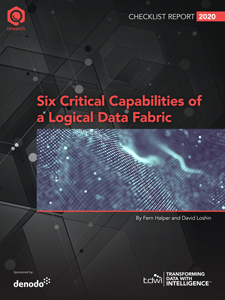
TDWI Checklist Report | Six Critical Capabilities of a Logical Data Fabric
May 11, 2020
Within recent years, the ability and need to develop flexible and scalable high-performance environments has radically changed the methods and processes for reporting, business intelligence, and analytics. As organizations opt for cloud computing platforms and migrate their data and applications to a hybrid cloud environment, they utilize multiple platforms to support new and increasing data types for analytics.
The challenge, though, is that without good practices and organization for your hybrid data environment, there is an increased risk of added complexity when data consumers search for and access the data assets they need to do their jobs. One way to manage data across this distributed environment and use it for analytics is to consider a modern approach—a logical data fabric—to unify disparate data and bring it together in an intelligent fashion.
This checklist describes six important capabilities of the logical data fabric to deal with modern data management and analytics efforts that will include multiple platforms, new data types and sources, and more advanced analytics.